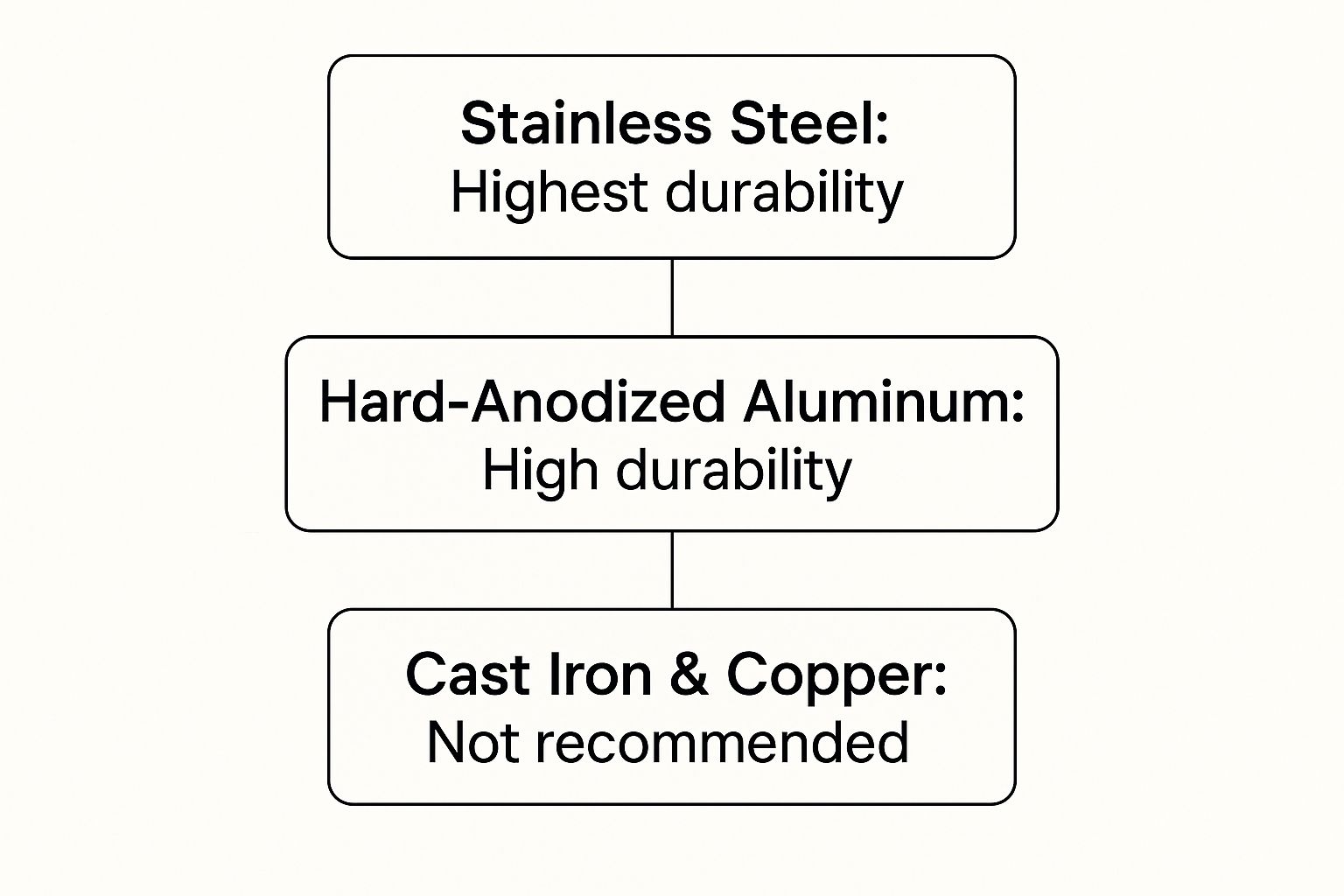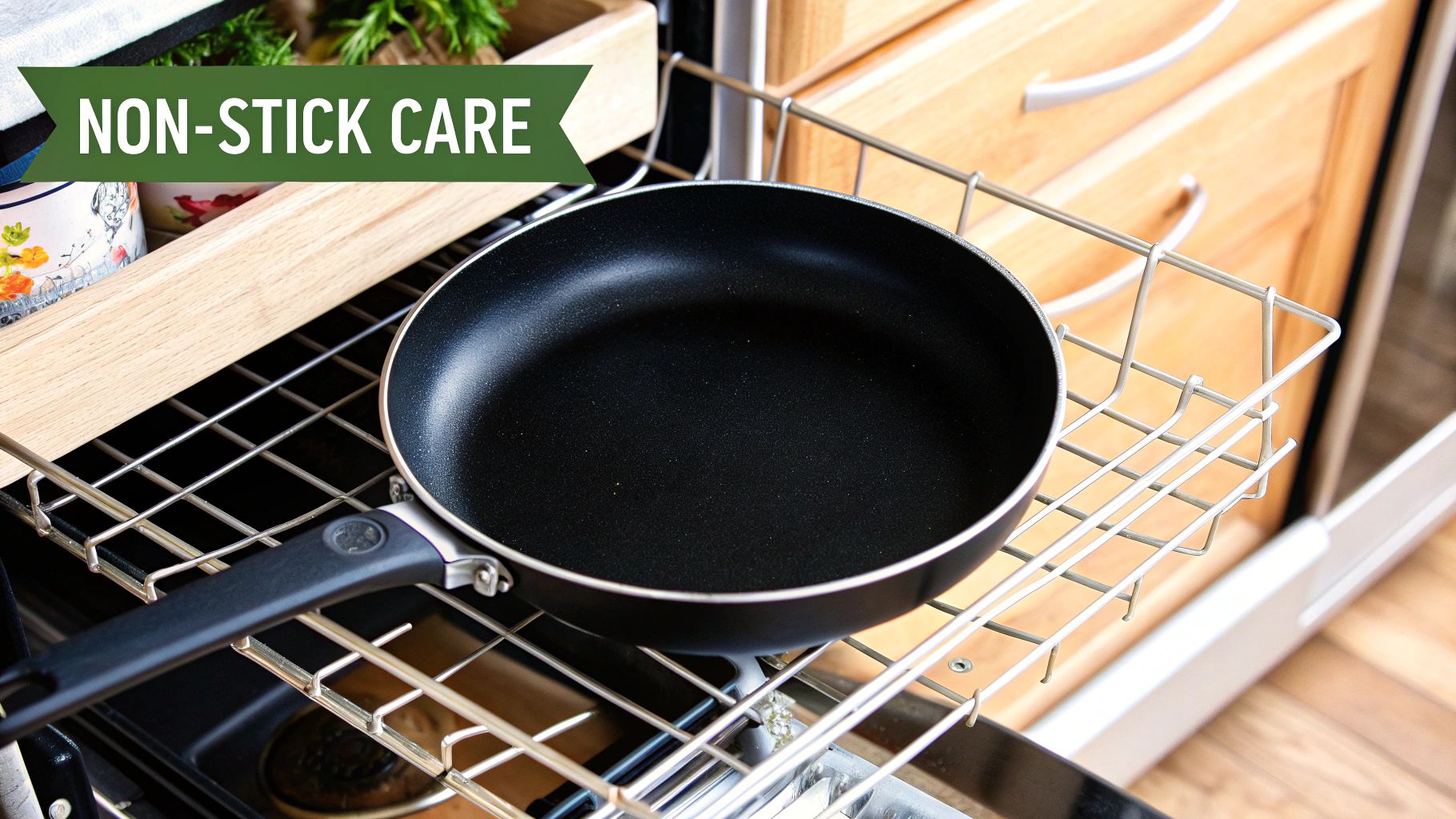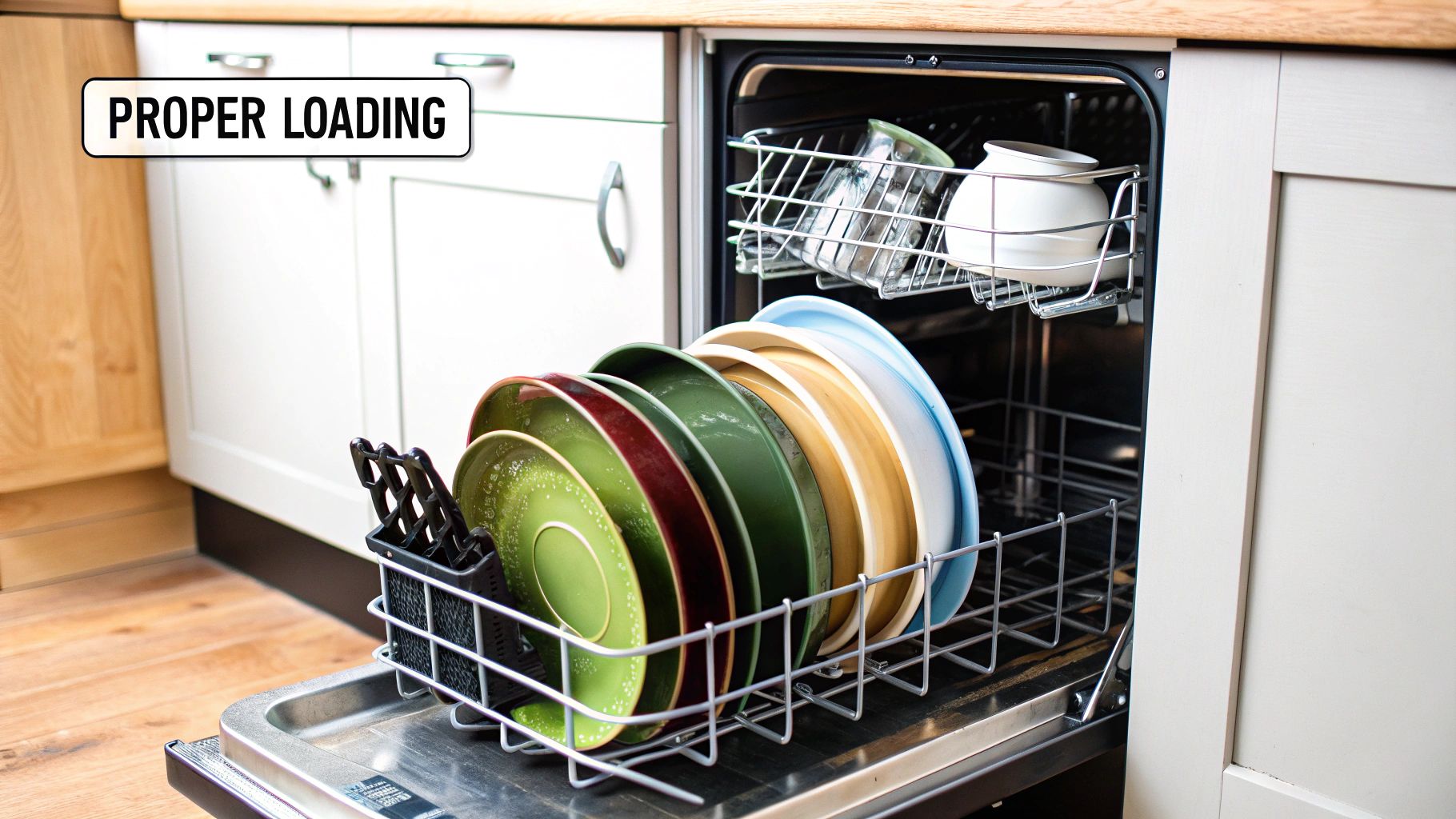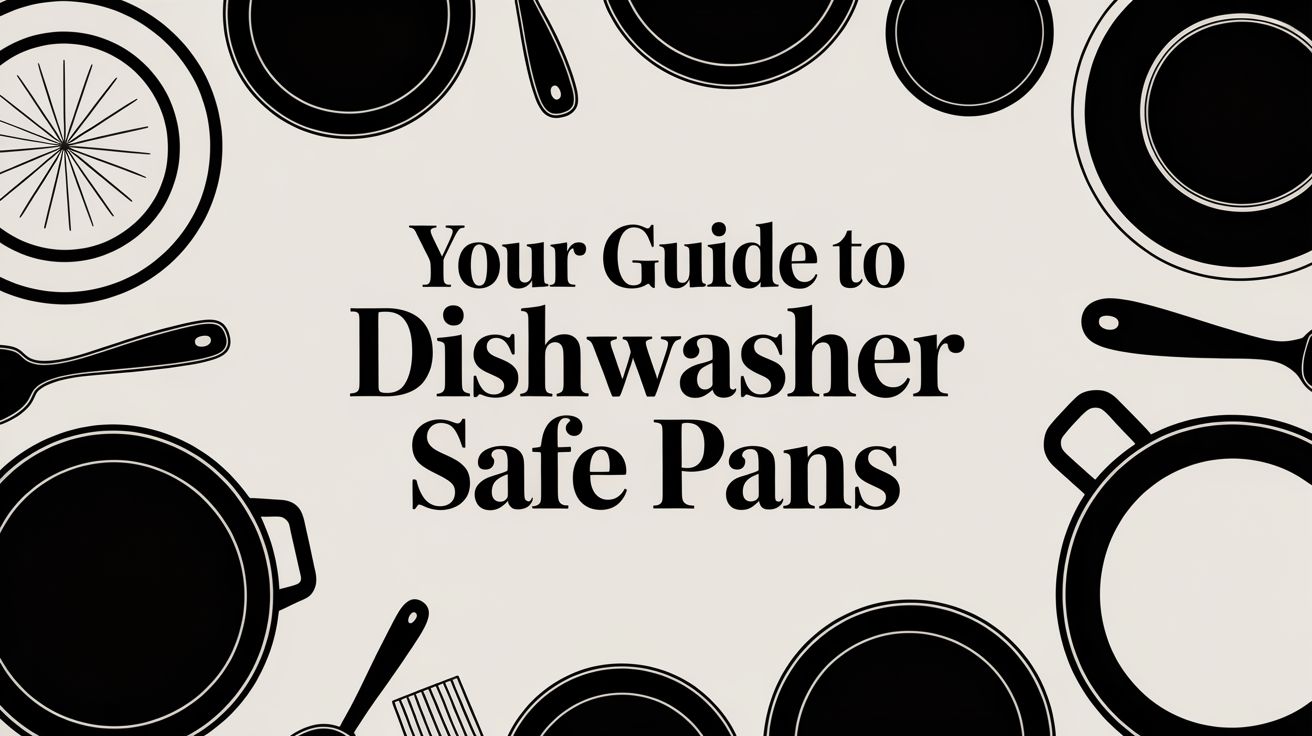Let's be real for a moment—nobody enjoys scrubbing baked-on food from a pan after a good meal. It’s one of the worst parts of cooking, which is why dishwasher safe pans feel like such a lifesaver. These kitchen heroes promise to take the grunt work out of cleanup, saving you time and effort.
Why We All Want an Easier Kitchen Cleanup
The search for simpler cleanup isn't just about convenience; it's a reflection of our busy lives. Time is precious. After a long day, the last thing anyone wants is to stand over the sink, scrubbing away at stubborn pots and pans. Dishwasher safe cookware offers a brilliant, practical solution. It turns a dreaded chore into the simple task of loading the machine and pressing a button.
This shift towards efficiency has really pushed the kitchenware industry forward. The demand for durable, low-maintenance cookware has spurred on some incredible innovations in materials and coatings—all designed to withstand the harsh environment of a dishwasher with its high heat, powerful water jets, and strong detergents.
The Rise of Dishwasher-Ready Homes
It's no surprise that the popularity of dishwasher safe pans in Australia has grown alongside the number of households with a dishwasher. As more of us embrace this appliance, our expectations for cookware have naturally evolved.
This trend is clearly visible in the market stats. The Australian dishwasher market was valued at USD 258.44 million in 2024 and is expected to climb to an impressive USD 600.69 million by 2033. This growth sends a clear signal: we want kitchen tools that fit seamlessly into a more automated, time-saving routine. You can explore more data about these market trends and see how they’re shaping the cookware we buy.
By understanding the 'why' behind this trend, we can better appreciate the 'what' and 'how' of selecting, using, and caring for pans designed for the modern kitchen.
This guide is about looking beyond the simple "dishwasher safe" label. We’ll get into the nitty-gritty of what really matters, including:
- The robust materials that make cookware truly resilient.
- How to properly look after your pans to get the most out of them.
- What to look for so you can feel confident investing in your next set of pans.
Think of this as your complete roadmap to choosing cookware that works just as hard as you do.
What Makes a Pan Dishwasher Safe
Ever wondered what that "dishwasher safe" label on a pan really means? It’s more than just a marketing buzzword. It's a promise that the pan's materials and construction are tough enough to handle the punishing environment inside a modern dishwasher.
Think of it like your laundry—you wouldn’t throw a delicate wool jumper in on a hot cycle. It's the same principle. The combination of intense heat, high-pressure water jets, and harsh detergents can wreck cookware that isn't built for it. It all comes down to the science of the materials.
The Champions of Durability
So, what materials can actually take the heat?
At the very top of the list, you’ll find stainless steel. We’re not talking about just any stainless steel, though. High-quality grades like 18/10 (which refers to its chromium and nickel content) are naturally non-porous and incredibly resistant to rust and corrosion. This is what makes them a star performer in the dishwasher.
The solid nature of stainless steel means it won't easily pit, warp, or stain, even after countless cycles. It’s the dependable denim jacket of the cookware world—tough, reliable, and built to last. This is precisely why it's a favourite for both professional chefs and busy home cooks.
Another fantastic option is hard-anodised aluminium. This isn't your flimsy takeaway container material. It’s aluminium that has undergone an electrochemical process, creating a surface that is exceptionally hard and non-reactive. It's significantly stronger than standard aluminium and stands up brilliantly to scratches, corrosion, and the dishwasher.
This infographic breaks down which common cookware materials are the most durable for dishwasher use.

As you can see, stainless steel sits at the top for durability, with hard-anodised aluminium not far behind. On the other end, materials like traditional cast iron and copper are best kept far away from the dishwasher.
Materials to Handle With Care
On the flip side, some popular materials should never go in the dishwasher. Cast iron is the classic example. Its magic lies in its "seasoning"—a baked-on layer of oil that creates a natural non-stick surface.
The potent combination of hot water and abrasive detergents in a dishwasher will strip that seasoning away completely. This leaves the raw iron exposed and vulnerable to immediate rusting.
Other materials react poorly to the harsh chemical environment of a dishwasher:
- Copper: It’s a brilliant heat conductor, but the strong chemicals in dishwasher tablets will cause it to tarnish and discolour almost instantly.
- Untreated Aluminium: A standard, non-anodised aluminium pan will likely oxidise, leaving it with pits and a dull, chalky residue after just one wash.
- Wood Components: If your pan has a wooden handle or knob, keep it out of the dishwasher. The extreme heat and moisture will make the wood swell, crack, and eventually fall apart.
To help you keep track, here’s a quick reference guide on which materials can handle the dishwasher and which can't.
Cookware Material Dishwasher Compatibility Guide
| Material | Dishwasher Safe? | Key Considerations |
|---|---|---|
| Stainless Steel (18/10) | Yes (Best Choice) | Extremely durable and resistant to rust, corrosion, and staining. |
| Hard-Anodised Aluminium | Yes (Good Choice) | The treated surface is non-reactive and scratch-resistant. |
| Non-Stick (Teflon/Ceramic) | Check Manufacturer | Often safe, but high heat can degrade the coating over time. |
| Cast Iron | No (Avoid) | Strips the essential oil seasoning and will cause immediate rusting. |
| Copper | No (Avoid) | Will tarnish and discolour due to harsh detergents. |
| Untreated Aluminium | No (Avoid) | Can oxidise, leading to pitting and a dull, chalky finish. |
| Wooden Handles/Parts | No (Avoid) | Wood will swell, crack, and deteriorate from heat and moisture. |
Ultimately, choosing the right material isn’t just about making clean-up easier; it also impacts your entire cooking experience. To dive deeper into how different materials can affect your food, check out our guide on finding the best healthy cooking pans. Knowing what your cookware is made of is the first step to building a collection that's a pleasure to cook with and a breeze to maintain.
Solving the Non-Stick Pan Dilemma
Ah, the non-stick pan. It’s the hero of countless weeknight dinners and weekend breakfasts, but its relationship with the dishwasher is… complicated. Many of us handle them with kid gloves, convinced that one wrong move—one wash cycle—will spell the end of their slick surface. But I've got some good news: things have changed.

"Non-stick" isn't a single material; it's a coating. The early versions were notoriously delicate, but today's coatings are engineered to be seriously tough. High-quality dishwasher safe pans often have multiple, reinforced layers that are built to handle the daily grind of both cooking and cleaning.
This push for durability isn’t a coincidence. It’s a direct response to how we live. In Australia and New Zealand alone, the non-stick cookware market was valued at USD 254.62 million in 2024, and it's set to keep growing. That number tells a story: we lead busy lives and need cleanup to be fast and easy, which has forced manufacturers to get serious about creating tougher, more resilient pans. You can read more about these cookware market trends to see how our needs are shaping the gear in our kitchens.
Protecting Your Non-Stick Surface
Even with all the modern advancements, a bit of smart care goes a long way. Just because a pan is labelled "dishwasher safe" doesn't mean it's invincible. A few simple habits will keep that surface slippery and effective for years to come.
The real trick is to buffer your pan from the dishwasher's harsh environment. That combination of intense heat, high-pressure water jets, and gritty detergents can slowly chip away at even the most robust coatings over time.
Think of it like this: your favourite jumper might be machine washable, but you probably use a gentle cycle and a mesh bag to keep it looking new. The same idea applies to your non-stick pans.
Taking a slightly gentler approach is the best way to get the maximum lifespan out of your cookware, ensuring your eggs keep sliding and cleanup stays effortless.
Best Practices for Dishwasher Use
To keep your non-stick pans in prime condition, just follow these simple but effective rules when it's their turn in the dishwasher.
- Stick to the Top Rack: The heat is far less intense up top, which is much kinder to the non-stick coating. It also stops the pan from acting like a giant umbrella, blocking water from reaching everything else.
- Avoid Aggressive Cycles: Skip the heavy-duty "pots and pans" or sanitising settings. A normal or eco-cycle has plenty of cleaning power without blasting the surface with extreme heat.
- Use a Milder Detergent: Try to choose detergents that are free from bleach and citrus additives. These ingredients can be surprisingly abrasive and might cause the coating to degrade faster than you'd like.
- Give Them Some Room: Never cram the dishwasher full. Make sure your pans aren’t rattling against other metal utensils or sharp-edged dishes, as this is a surefire way to get scratches during the cycle.
Following these tips means you can enjoy the convenience of the dishwasher without cutting the life of your cookware short. For more detailed advice, you might want to check out our guide on non-stick frying pans with lids.
How to Wash Your Pans in the Dishwasher
Seeing the 'dishwasher safe' label on a new pan feels like a win, but it’s not a blank cheque to just toss it in and hope for the best. Think of that label as the starting line, not the finish line. There's a real art to loading your dishwasher safe pans correctly, one that protects your investment and keeps them cooking beautifully for years, not just a few months.

Stick to a few simple but critical steps, and you'll sidestep common headaches like weird discolouration, warping, or the slow-motion death of a non-stick coating. This is your playbook for keeping that cookware in top form, wash after wash.
The Pre-Wash Prep
Before your pan even sees the inside of the dishwasher, a little prep work goes a long way. You're not trying to scrub it clean, just giving the machine a fighting chance.
Grab a silicone scraper or a bit of paper towel and get rid of any big chunks of food and leftover grease. This quick wipe-down stops that gunk from getting baked on during the hot drying cycle. As a bonus, it helps keep your dishwasher’s filter from clogging up, which means a better wash for everything else in the load.
Perfecting Your Placement Strategy
Where you put your pans in the dishwasher is probably the most important part of the whole deal. Bad placement means a poor clean at best and damaged cookware at worst.
Here’s how to nail it every time:
- Bottom Rack is Best: Your pots and pans should always go on the bottom rack. Place them face down or on a slight angle to give them prime access to the powerful water jets spraying up from the bottom.
- Avoid Overlapping: Stacking pans or letting them lean against each other is a big no-no. It creates "water shadows"—spots the spray simply can't reach, leaving you with dirty patches.
- Give Them Space: Make sure there’s plenty of room around each pan for the water and detergent to do their thing. A crowded dishwasher is an inefficient one, and it also increases the risk of your good pans getting scratched up from bumping into other items.
Think of it this way: the goal is maximum exposure to those cleaning jets. A pan that’s blocking the spray isn’t just getting a bad wash itself; it’s preventing other dishes from getting clean too.
Choosing the Right Cycle and Detergent
Finally, let’s talk settings and soap. The cycle you pick and the detergent you use have a huge impact on your pan's lifespan. The wrong combination can be surprisingly abrasive.
When it comes to dishwasher safe pans, especially anything with a non-stick surface, a gentler detergent is your best friend. Look for products that don't contain bleach, citrus oils, or other harsh chemicals. These can slowly strip away coatings and leave the finish on stainless steel looking dull.
Along the same lines, steer clear of super-hot settings like "sanitise" or heavy-duty cycles unless you’re dealing with a serious mess. A normal or eco-cycle has more than enough cleaning power for most jobs and won't expose your cookware to the extreme heat that causes warping over time.
Choosing the Right Dishwasher-Safe Cookware
https://www.youtube.com/embed/lCgD9FweFvk
Walking down the cookware aisle can be a bit dizzying, but picking out the right dishwasher-safe pans doesn't have to be. Once you know what to look for, the choice becomes much clearer. It’s about more than just the material; the best pans are a blend of smart design, solid performance, and the kind of durability that makes them a kitchen staple for years to come.
This is a decision more and more of us are making. In fact, the Australian kitchenware market hit around USD 3.85 billion in 2024, and it's only set to grow. We're all looking for cookware that's hygienic, convenient, and built to last—things that fit right in with healthier cooking and our need for a quick clean-up. This shift explains why dishwasher-safe pans are becoming so popular across the country.
What to Look for Beyond the Label
Seeing "dishwasher safe" on the box is a great start, but the real story is in the details. The way a pan is built will tell you everything you need to know about how it will hold up over time.
-
Handle Construction: This is often the first thing to fail. Look for handles that are solidly riveted to the body of the pan. Steer clear of pans with wooden or flimsy plastic handles, as the intense heat and moisture in a dishwasher can cause them to warp, crack, or fade. All-metal handles, especially stainless steel, are your best bet for longevity.
-
Weight and Balance: Pick up the pan. It should feel substantial and well-balanced. If it feels too light, that’s a red flag for thin construction, which can lead to annoying hot spots and warping. On the flip side, a pan that's excessively heavy can be a pain to use every day. You're looking for that sweet spot: sturdy, but not a workout to lift.
Decoding Pan Materials and Coatings
As we've touched on, the pan's core material is crucial. High-quality stainless steel and hard-anodised aluminium are champions when it comes to standing up to harsh detergents and high heat.
But if you're leaning towards a non-stick pan, the type of coating is just as important as the metal underneath.
The best modern non-stick surfaces are often beefed up with other materials to make them last longer. Some of the toughest coatings, for example, are infused with titanium. This adds a serious layer of strength and scratch resistance, helping the surface handle both cooking utensils and the rigours of a dishwasher cycle. If you want cookware that’s both durable and non-toxic, it pays to understand what you're buying. For a deeper dive, check out our guide on titanium cookware in Australia.
By looking at the handle, checking the balance, and understanding the coating technology, you're making a much smarter choice. You're no longer just trusting a label; you're spotting the signs of a well-crafted pan that’s designed for great cooking and even better cleaning. That's how you end up with cookware you'll genuinely love using for years.
Common Questions About Dishwasher-Safe Pans
It’s a common question in many kitchens: is it really okay to put that expensive pan in the dishwasher? Even when it says "dishwasher-safe," there's often a bit of hesitation. Let's clear up the confusion.
We'll tackle some of the most frequent concerns people have, helping you sidestep common mistakes and get the most out of your dishwasher-safe pans.
- Can a dishwasher actually damage a pan labelled “dishwasher-safe”?
- What really happens if I put a non-safe pan through a cycle?
- Are all stainless steel pans automatically safe for the dishwasher?
- How do I know when it's time to retire a non-stick pan?
Can a Dishwasher Damage "Safe" Pans?
In short, yes. Even a well-made, dishwasher-safe pan can start to show wear and tear after too many cycles in the machine.
The combination of intense heat, high-pressure water jets, and harsh detergents is a tough environment. Over time, it can dull a pan's finish or cause minor cosmetic issues.
A shiny stainless steel pan, for instance, might lose a bit of its lustre or pick up faint scratches. It's rare for this to cause structural damage, but the cosmetic toll is real.
“Even the toughest cookware benefits from gentle cycles and milder detergents,” says cookware expert Jane Smith.
To keep your pans looking and performing their best:
- Try alternating between hand washing and using the dishwasher.
- Opt for a gentler, less aggressive wash cycle when you can.
- Stick to mild, bleach-free detergents.
These small habits make a huge difference. Think of it this way: tossing a pan caked with tomato sauce into the machine on its toughest setting might leave it looking dull and spotty. A few simple adjustments turn that harsh process into a gentle clean that preserves your pan's good looks and cooking performance.
What Happens If You Wash Non-Safe Pans?
Putting a pan that isn't dishwasher-safe into the machine can cause immediate and sometimes irreversible damage.
A cast iron skillet, for example, will be stripped of its precious seasoning and can start to rust almost instantly.
Copper pans can tarnish or develop pits from the aggressive detergents, while pans with wooden handles are likely to warp, swell, or even crack. Certain types of aluminium will also discolour and pit badly.
It’s like tossing a delicate wool jumper into a hot wash cycle—the material simply isn't built to withstand that kind of treatment.
I learned this the hard way once after accidentally washing a non-rated skillet. It came out with ugly, permanent stains. That one mistake taught me to always double-check the care instructions before loading up the dishwasher.
Are All Stainless Steel Pans Dishwasher Safe?
Not all stainless steel is created equal, and you can't assume every stainless pan is dishwasher-safe.
Generally, high-grade 18/10 stainless steel pans with solid steel handles are a safe bet.
The trouble starts when other materials are involved. Pans with wooden or certain plastic handles can't handle the heat and moisture. Others might have an aluminium or copper core that's exposed at the rim, which can be corroded by harsh detergents over time.
When in doubt, always check what the manufacturer recommends.
To be sure, look at three key things when choosing a stainless steel pan for dishwasher use:
- Handle Material: Make sure it can withstand high heat and prolonged moisture.
- Core Construction: The best designs have the core fully enclosed in stainless steel.
- Bonding: Any sealants or bonding agents used in its construction need to be rated for dishwasher use.
When To Retire Your Non-Stick Pan
Knowing when to say goodbye to a non-stick pan is really important for both food safety and cooking performance.
Give the surface a quick inspection before you use it.
If you see deep scratches that expose the metal underneath, or if the coating is starting to flake or peel away, it's definitely time for a replacement. Another dead giveaway is when your food starts sticking all the time, even with oil.
Replacement is better than risking chipped coating bits in your meal.
A retired non-stick pan doesn't have to go straight to the bin! It could find a second life as a planter for kitchen herbs. But when it comes to cooking, you want fresh performance from fresh cookware.
By keeping these tips in mind, you can treat your cookware with the respect it deserves and ensure every meal starts with a clean, reliable pan.
Looking for cookware that lasts a lifetime and shines after every wash? Explore Everti pure titanium essentials and make cleanup a breeze. Visit https://everti.com.au.

